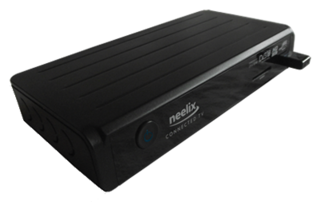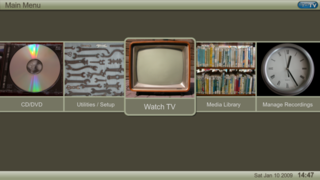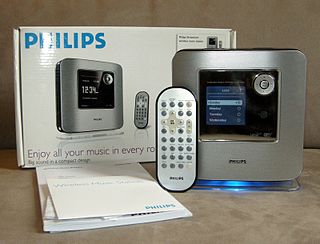This article includes a list of references, related reading or external links, but its sources remain unclear because it lacks inline citations .(January 2013) (Learn how and when to remove this template message) |
RSS-TV is an XML-based navigation protocol for Internet media services based on the RSS standard.
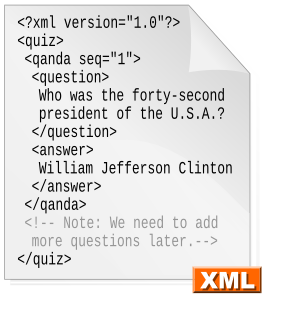
Extensible Markup Language (XML) is a markup language that defines a set of rules for encoding documents in a format that is both human-readable and machine-readable. The W3C's XML 1.0 Specification and several other related specifications—all of them free open standards—define XML.
RSS is a type of web feed which allows users and applications to access updates to online content in a standardized, computer-readable format. These feeds can, for example, allow a user to keep track of many different websites in a single news aggregator. The news aggregator will automatically check the RSS feed for new content, allowing the content to be automatically passed from website to website or from website to user. This passing of content is called web syndication. Websites usually use RSS feeds to publish frequently updated information, such as blog entries, news headlines, or episodes of audio and video series. RSS is also used to distribute podcasts. An RSS document includes full or summarized text, and metadata, like publishing date and author's name.
Contents
The adoption of RSS-TV enables video device manufacturers to develop applications to navigate Internet media services. Example video devices include set top boxes, game consoles, broadband-connected digital video disc (DVD) players, digital video recorders (DVRs), personal video recorders (PVRs) and next-generation mobile phones. By implementing the RSS TV protocol, these devices provide user access to a growing library of online media (video, audio and games) services.

Video is an electronic medium for the recording, copying, playback, broadcasting, and display of moving visual media. Video was first developed for mechanical television systems, which were quickly replaced by cathode ray tube (CRT) systems which were later replaced by flat panel displays of several types.

A DVD player is a device that plays DVD discs produced under both the DVD-Video and DVD-Audio technical standards, two different and incompatible standards. Some DVD players will also play audio CDs. DVD players are connected to a television to watch the DVD content, which could be a movie, a recorded TV show, or other content.
A digital video recorder (DVR) is an electronic device that records video in a digital format to a disk drive, USB flash drive, SD memory card, SSD or other local or networked mass storage device. The term includes set-top boxes with direct to disk recording, portable media players and TV gateways with recording capability, and digital camcorders. Personal computers are often connected to video capture devices and used as DVRs; in such cases the application software used to record video is an integral part of the DVR. Many DVRs are classified as consumer electronic devices; such devices may alternatively be referred to as personal video recorders (PVRs), particularly in Canada.
RSS-TV is an extension of RSS and includes additional XML elements and attributes to enable Premium TV-centric features such as:
- Video on demand (VOD) and Subscription video on demand (SVOD)
- Navigating media services (video, audio, games) in a hierarchical fashion
- Capturing user input (such as a user personal identification number (PIN), search query, or email) and automatic search suggestions.
- Network PVR functionality
- Secure download of HD content
- Electronic program guide for live streams
- Automatic language selection
- Numeric shortcuts for selecting menu items

Video on demand (VOD) is a programming system which allows users to select and watch/listen to video or audio content such as movies and TV shows whenever they choose, rather than at a scheduled broadcast time, the method that prevailed with over-the-air programming during the 20th century. IPTV technology is commonly used to bring VOD to televisions and personal computers. VOD does have some limitations which one of them is not having enough bandwidth to watch it.

A Personal Identification Number, pronounced "pin"; is a numeric or alpha-numeric password used in the process of authenticating a user accessing a system.
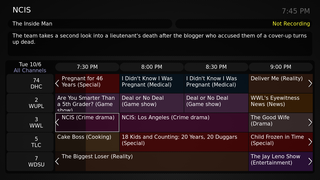
Electronic programming guides (EPGs) and interactive programming guides (IPGs) are menu-based systems that provide users of television, radio and other media applications with continuously updated menus that display scheduling information for current and upcoming broadcast programming. Some guides also feature backward scrolling to promote their catch up content. They are commonly known as guides or TV guides.
Readers familiar with Digital Video Broadcasting (DVB) can compare RSS-TV with the DVB Service Information standards developed in the 1990s for digital TV EPGs. The difference is that RSS-TV has been developed for two-way Internet Protocol (IP) networks rather than broadcasting networks. RSS-TV leverages the increasing availability of products that support RSS such as caching engines and RSS-enabled content management and publishing systems.

Digital Video Broadcasting (DVB) is a set of international open standards for digital television. DVB standards are maintained by the DVB Project, an international industry consortium, and are published by a Joint Technical Committee (JTC) of the European Telecommunications Standards Institute (ETSI), European Committee for Electrotechnical Standardization (CENELEC) and European Broadcasting Union (EBU).
RSS-TV compliant applications can be implemented using any language and operating system including AJAX/HTML, Flash, OpenTV, or C. Similarly, service providers can use any web service technologies (Java, .NET, PHP) to build RSS-TV compliant services.
PHP: Hypertext Preprocessor is a general-purpose programming language originally designed for web development. It was originally created by Rasmus Lerdorf in 1994; the PHP reference implementation is now produced by The PHP Group. PHP originally stood for Personal Home Page, but it now stands for the recursive initialism PHP: Hypertext Preprocessor.

